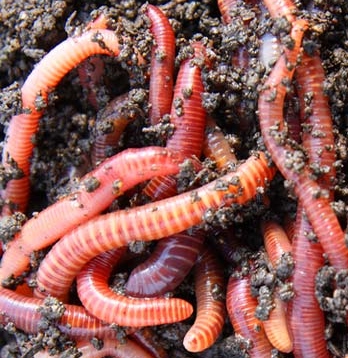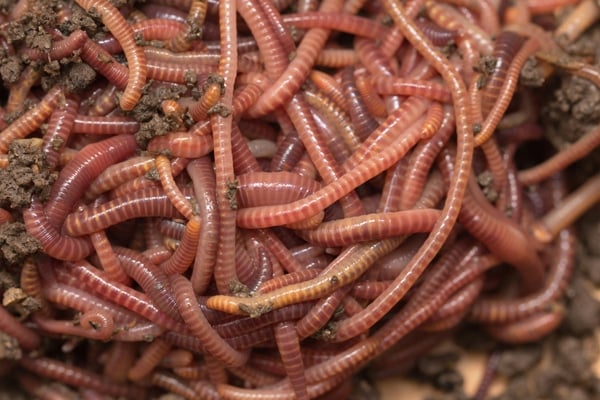Thriving red wigglers: Their role in reducing waste
Thriving red wigglers: Their role in reducing waste
Blog Article
The Role of Red Wigglers in Lasting Gardening
The assimilation of red wigglers right into lasting gardening techniques provides a compelling method to enhancing soil health and wellness and lowering natural waste. These organisms not just convert kitchen scraps right into nutrient-dense compost via vermicomposting but also freshen the dirt, promoting ideal conditions for plant development. As they damage down complicated natural products, they actively foster a prospering microbial ecosystem essential for lasting farming. Nonetheless, the ramifications of utilizing red wigglers extend past plain composting; their function in forming a more sustainable future warrants a much deeper expedition of their advantages and sensible applications.
Understanding Red Wigglers
Red wigglers, medically called Eisenia fetida, are a types of earthworm renowned for their function in sustainable gardening and composting methods - red wigglers. These worms prosper in decaying organic matter, making them particularly effective in transforming kitchen scraps and lawn waste right into nutrient-rich compost. Unlike standard earthworms, red wigglers have a greater tolerance for differing dampness levels and can grow in settings with bountiful natural material
(redworms for composting)Classically, red wigglers are smaller than their earthworm equivalents, generally measuring between 3 to 4 inches in size. They possess a reddish-brown pigmentation and have a fractional body structure that assists in their burrowing and feeding tasks. These organisms are hermaphroditic, indicating each private possesses both male and female reproductive organs, which allows for effective populace development under ideal conditions.
The habitat preferences of red wigglers include moist, dark settings abundant in organic web content, such as garden compost containers or worm ranches. Their ecological duty extends beyond composting; they are important in aerating the soil and assisting in nutrient cycling, which ultimately adds to healthier garden communities. red wigglers. Recognizing the biology and behavior of red wigglers is important for those looking for to execute efficient vermicomposting in lasting horticulture
Advantages of Vermicomposting
Vermicomposting offers many benefits that improve lasting horticulture practices and add to environmental health. One of the primary advantages is the improvement of organic waste into nutrient-rich compost, which enhances dirt structure and fertility. The castings generated by red wigglers are loaded with beneficial bacteria and vital nutrients, making them an outstanding all-natural plant food.
Additionally, vermicomposting dramatically minimizes landfill waste. By drawing away cooking area scraps and backyard waste from land fills, this technique not only reduces methane emissions-- a potent greenhouse gas-- however additionally promotes a round economic climate, where waste is repurposed as a resource.
One more benefit is the enhancement of soil oygenation and drain (red wigglers). The burrowing activity of red wigglers develops channels in the dirt, permitting air and water to penetrate more easily, thus fostering a much healthier origin system for plants
Furthermore, vermicomposting can be done on a small scale, making it obtainable for urban garden enthusiasts and those with restricted space. This method encourages environmental stewardship and awareness, as people become a lot more engaged with their waste management techniques. Ultimately, vermicomposting represents a sustainable, effective, and environmentally friendly approach to gardening that benefits both plants and the planet.
How to Beginning Vermicomposting
Beginning your very own vermicomposting system can be a fulfilling endeavor that boosts your sustainable gardening methods. To start, pick an appropriate container, such as a plastic container or wood box, with excellent drainage and air flow. The size will rely on the volume of kitchen scraps you create; a bin of 10-14 gallons generally is adequate for a house.
Following, prepare the bed linen material. Shredded newspaper, cardboard, and coconut coir are superb options, offering a comfy environment for the red wigglers. Go for a bed linen depth of concerning 4-6 inches, which ought to be damp however not soggy.
When the bed linens is established, introduce your worms. Red wigglers (Eisenia fetida) are the most suitable for composting. Start with approximately one pound of worms for every 2-3 pounds of kitchen scraps weekly.
Begin adding kitchen area waste, avoiding meat, dairy products, and oily foods, as these can draw in bugs and develop smells. Routinely keep track of the container's dampness degrees and temperature, ensuring it continues to be within the optimal variety for worm task. With these first actions, you'll be well on your way to producing nutrient-rich garden compost for your garden.
Keeping a Healthy Worm Container
A prospering worm container requires consistent care and interest to keep an optimal atmosphere for the red wigglers. Trick variables to keep an eye on consist of moisture degrees, temperature level, and food supply. Preserving a wetness degree akin to a wrung-out sponge is vital; too wikipedia reference much water can cause anaerobic problems, while insufficient can dehydrate the worms.
Temperature is likewise important, as red wigglers prosper in a series of 55 to 77 levels Fahrenheit. Extreme temperature levels can worry the worms, potentially bring about death. Therefore, putting the container in a climate-controlled area or making use of shielding materials can assist control temperature variations.

Finally, aeration is vital. Frequently transforming the bed linens and utilizing a fork or shovel can protect against compaction and advertise air flow, making sure a healthy and balanced, growing environment for the red wigglers. By sticking to these techniques, gardeners can preserve a productive worm container that sustains lasting horticulture initiatives.
Effect On Dirt Wellness
Enhancing dirt health and wellness via making use of red wigglers is a fundamental aspect of lasting gardening. These worms, understood clinically as Eisenia fetida, play an essential role in enhancing soil framework and fertility. By taking in raw material, red wigglers damage down complex materials right into easier compounds, a process referred to as vermicomposting. Completion item, worm castings, is rich in crucial nutrients, consisting of nitrogen, phosphorus, and potassium, which are important for plant growth.

(red wigglers for sale near me)Studies have revealed that soils improved with worm castings show increased microbial task and enhanced fertility, causing higher plant yields. By incorporating red wigglers into gardening techniques, garden enthusiasts not just enrich their dirt yet likewise contribute to a much more lasting agricultural system, stressing the interconnectedness of dirt wellness and environmental stewardship.

Verdict
Finally, red wigglers dramatically add to lasting horticulture via their efficient vermicomposting methods. Their capability to transform organic waste right into nutrient-rich compost enhances soil fertility and sustains a varied microbial ecological community. In addition, their burrowing activity enhances soil aeration and water retention, benefiting plant health and wellness. By advertising waste reduction and promoting a round economic climate, red wigglers become necessary parts in environment-friendly horticulture initiatives, underscoring their vital function in environmental sustainability.
Report this page